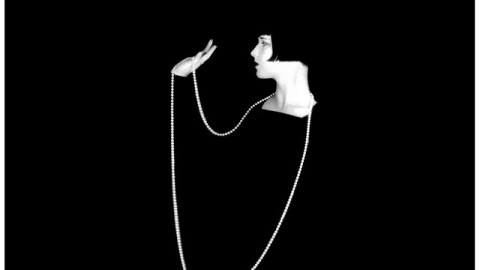Why Silent Film Stills Still Fascinate Us

Fewer than 14% of American silent films still exist today in complete form according to “The Survival of American Silent Feature Films: 1912-1929,” a recent Library of Congress report by film historian David Pierce. All we know today of the vast majority of those lost films are either tantalizing fragments of footage or the still photographs taken to advertise and promote the movies and their stars. Looking at those still photographs now reminds us of whole worlds and personalities lost to time. David S. Shields’ Still: American Silent Motion Picture Photography masterfully recreates and celebrates a genre of photography originally intended as a marketing tool but today recognized for its own artistry, separate from but still related to the films and actors it saves from the dustbin of history. “Photography preserved what was most vivid and splendid about silent cinema, the unprecedented visual elaboration of places and people—the beauty, the horror, the moodiness,” Shields writes in rebuttal to modern viewers bored by the perceived limitations of the silent films. Silent film stills, Shields believes, “speak with a force little diminished by ninety years of history.” Shields, likewise, speaks with a force powered not just by his passion for and knowledge of the field, but also by sharing the stage with the work itself in his beautifully illustrated book. By its end, Still reminds us why silent film stills still fascinate us.
“Beauty was the trump of trumps—the quality that could change a shopgirl into a society matron, a slumgullion into a star,” Shields asserts. “It was, par excellence, that quality explored in the publicity photography generated by silent cinema.” Beautiful faces captured in still photography found themselves looking down from the walls of theater lobbies, from publicity prints handled by collectors and fans, and from the newspapers and magazines with their ever increasing hunger for imagery as print technology allowed photography to be reproduced on a mass scale as never before. Shields resists postmodern readings of silent motion picture photography fixated on the “male gaze” that renders female subjects passive objects rather than the active participants in a creation of identity founded on the earliest ideas about glamour. Instead, Shields hopes to “recast[] the story of glamour… by recognizing the primacy of the visual culture of the stage in these developments and exploring the relocation of the focus of glamour from the vicinity of the face in girl glamour to the luminous body in woman glamour.”
Along the way, we meet such forgotten stage figures as Elsie Ferguson, an early Broadway star convert to motion pictures, none of which survive today except through stills. Where Ferguson “gave good face” (as Madonnavogued over Greta Garbo), other actresses such as Evelyn Nesbit embodied more three-dimensional charms. “Nesbit flares with the flame of the flesh,” Shields waxes poetically. “Ferguson shines with the luminosity of the soul—to use the characterizations of that era.” Despite such analysis, Shields contends that his “aim is not to deconstruct beauty or excavate the dubious political visions that subtended the worlds articulated in silent film photography.” Instead, he hopes “to understand the enchantment” that made these films and the people in them iconic around the world. Rather than murder through dissection, Shields wants to “recover a poetics of mystification” and thus restore some of the magic viewers experienced when they first saw these stills and the cinematic pleasures they promised. It’s a tall task—nothing less than creating a photographic time machine for the film-lover’s soul—but Shields delivers more than his share of magic.
Perhaps Shields’ greatest trick is not in reminding us of those who stood in front of the cameras—moving and still—but in introducing the mainstream photography fan to the people behind the camera—the visionaries who translated charisma onto the negative: Richard Matzene, who wanted his subjects “poised” not “posed”; Jack Freulich, who helped Theda Bara become the original “vamp” and found manly beauty in wrinkles and peculiar features; John Van den Broek, a stylist who “suggested the existence of whimsical, romantic worlds” in which “the exotic trumped the exotique” of faux, stereotypical orientalism; M.I. Boris, former portraitist of kings who manipulated negatives to create “uncanny” portraits that Shields feels anticipate “our age of digital aesthetics” by almost a century. These men and so many more come alive both through their photographs (many from Shields’ own collection) and through Shields’ vivid prose and exhaustive research.
Into this boys’ club of silent film still photography Shields inducts two actresses who contributed their visual insights to discover and inspire still photographers—Alla Nazimova and Lillian Gish. Nazimova served almost as her own art director in enticing photographer Arthur Rice to travel west to Hollywood despite ill health to photograph her as well as her friend, Rudolph Valentino, whom Rice turned into “a new male icon, fancier, more temperamental, more expressive than the matinee idols of the day,” Shields writes. Rice’s still photography for Nazimova’s 1923 Salomé perfectly captures the art nouveau artistry of the film, which, unlike so many other films, fortunately still exists complete. Shields devotes a whole chapter to “The Eyes of Lillian Gish,” who Shields feels “better knew how to convey [the] interior splendor and soulfulness… of the girl, the Anglo-Saxon angel” than any other woman (and probably better than any man, too). The antithesis of the sexual vamp, Gish perfected the inaccessible sexuality of a living, pseudo-religious icon. Gish discovered and inspired photographers such as James Abbe, who perfected an “intimate dark” in which actors caught candidly in costume fascinated viewers with the idea of “a mystery encountered”; Charles Albin, a tonalist who created portraits of “pearly luminousness” epitomizing the saintly Gish persona; and Milton Brown, whose stills for Gish’s last silent film, The Wind (1928), paradoxically capture the relentlessly blowing wind as “the external correlative of a woman’s soul… materializing the tortured anima.”
Shields’ ideas and expression pair beautifully with the photographs he selects to stand for the silent era. Bert Longworth’s famous “two shot” of Greta Garbo and John Gilbert in 1926’s Flesh and the Devil, known by aficionados simply as “The Lovers,” exudes the passion and romance of the best silent film couples. I’ve always had an interest in the films and photographs of actress Louise Brooks, so Eugene Robert Richee’s 1927 photo of Louise Brooks with pearls (detail shown above) brought all my “Lulu” love to the surface. (For those looking for an introduction to the world of silent films, I highly recommend Kevin Brownlow’s The Parade’s Gone By.) Shields managed to make even that familiar photo by “Mr. Still” Richee fresh for me with his analysis of how Richee used curves like the white line of pearls to mimic art nouveau lines as part of “[t]his minimalist masterpiece show[ing] the modernist beauty in subtraction. Beauty without ornament.” Just as Brooks’ head, hand, and pearls stand out in negative space against the inky sameness of black hair, dress, and backdrop, Shields’ ideas stand out against all the negativity stacked against silent films as things of the past.
In Still: American Silent Motion Picture Photography, David S. Shields emerges as the last romantic—a knight tilting against the windmills of what passes for modern glamour in a quest to show us what the real thing once looked like. He truly believes that “[t]he ingénue innocence radiating in the ‘girl’ portraits of certain early actresses seems strangely fresh to eyes glutted with the urban worldliness of current fashion photography or the preppy slut posturings of the more notorious of the current generation of young female celebrities.” The overt sexuality of contemporary culture robs us today of the glamour and charisma found in the best silent film stills. Pictures of Louise Brooks speak sexy just as loudly as those of Miley Cyrus—just in a different language. Shields wants us all “to recapture the freshness of that visual morning” when glamour was new and awakened the whole person, both the head and heart. Still: American Silent Motion Picture Photography is the perfect wake up call for those hoping for more from their idols.
[Image:Eugene Robert Richee. Louise Brooks with Pearls (detail), 1927.]
[Many thanks to the University of Chicago Press for providing me with a review copy of David S. Shields’ Still: American Silent Motion Picture Photography.]





